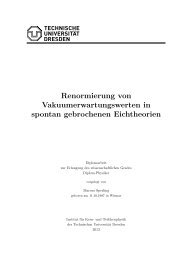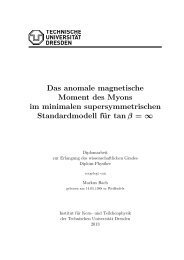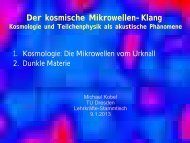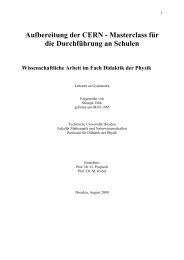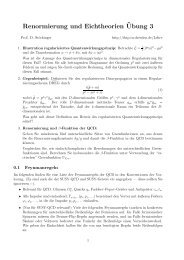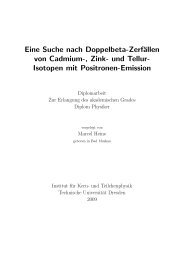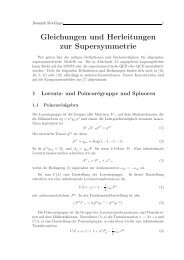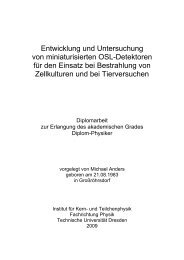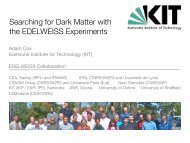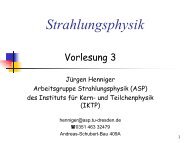a design study for a cobra upgrade to - Institut für Kern- und ...
a design study for a cobra upgrade to - Institut für Kern- und ...
a design study for a cobra upgrade to - Institut für Kern- und ...
Create successful ePaper yourself
Turn your PDF publications into a flip-book with our unique Google optimized e-Paper software.
5.1 Monte Carlo studies <strong>for</strong> the <strong>upgrade</strong> <strong>design</strong> 63<br />
kind of device size of<br />
out device number active area pe/keV σ/pe (%)<br />
PMT R6094 25 cm 2 4.05 2.07<br />
PMT R5900 25 cm 2 4.50 1.99<br />
PMT R669 25 cm 2 2.60 2.52<br />
APD S8664-1010 1 cm 2 1.96 2.87<br />
Si-PMT S10985-100C 0.36 cm 2 1.71 3.16<br />
Si-PMT S10985-050C 0.36 cm 2 1.34 3.57<br />
PIN S2744-08 4 cm 2 3.39 2.26<br />
APD’ S8664-1010 25 cm 2 24.53 1.13<br />
Si-PMT’ S10985-100C 25 cm 2 15.11 1.29<br />
Si-PMT’ S10985-050C 25 cm 2 11.83 1.39<br />
PIN’ S2744-08 25 cm 2 11.76 1.40<br />
Table 5.5: Pho<strong>to</strong> electron yield and relative standard deviation of the<br />
pho<strong>to</strong> electron yield at 662 keV <strong>for</strong> quantum efficiencies of different<br />
readout devices. Different sizes of active areas were considered, by<br />
using size of one commercial device (A) and size of 25 cm 2 (A’).<br />
In table 5.5, it is shown, that semiconduc<strong>to</strong>r readout devices, especially<br />
the APD are superior <strong>to</strong> PMTs with the same active area. The APDs<br />
produce more pho<strong>to</strong>electrons than silicon PMTs and PIN diodes, due<br />
<strong>to</strong> a higher quantum efficiency than PIN diodes and a larger active<br />
area than Si-PMTs, which have dead layers between individual pixels.<br />
If only one commercially available readout device is attached <strong>to</strong> the<br />
crystal, the PMT, having by far the biggest active area, can detect more<br />
pho<strong>to</strong> electrons than the other readout devices.<br />
This correlates with the relative variation of the amount of detected<br />
pho<strong>to</strong> electrons, which has the main influence on the obtained energy<br />
resolution. The smallest relative variation of produced pho<strong>to</strong> electrons<br />
have 25 cm 3 APDs with 1.13 % (RMS) and PMTs of about 2 % <strong>for</strong> commercial<br />
sizes. Single APD have a pho<strong>to</strong> electron yield variation of 2.9 %,<br />
which is about one third more than the variation of PMTs. It can be<br />
seen, that PMTs with bialkali pho<strong>to</strong> cathode still detect more pho<strong>to</strong>ns<br />
than commercial APDs and Si-PMTs.<br />
The obtained pho<strong>to</strong> electron yield variation considers the statistical<br />
variation of the production of optical pho<strong>to</strong>ns, the variations of the col-



